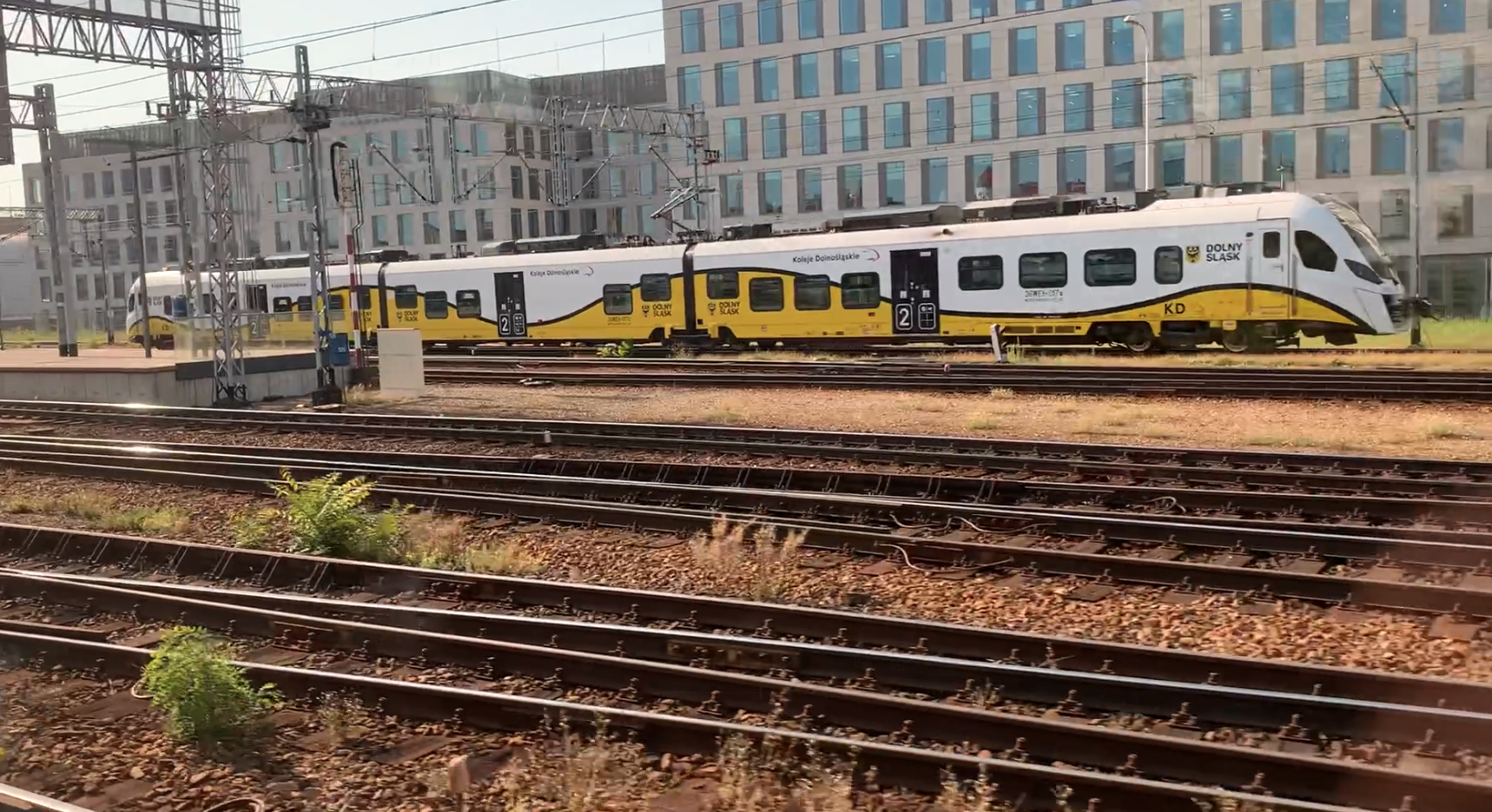Wrocław 2025-05-12
Koleje Dolnośląskie – Lower Silesian Railways.
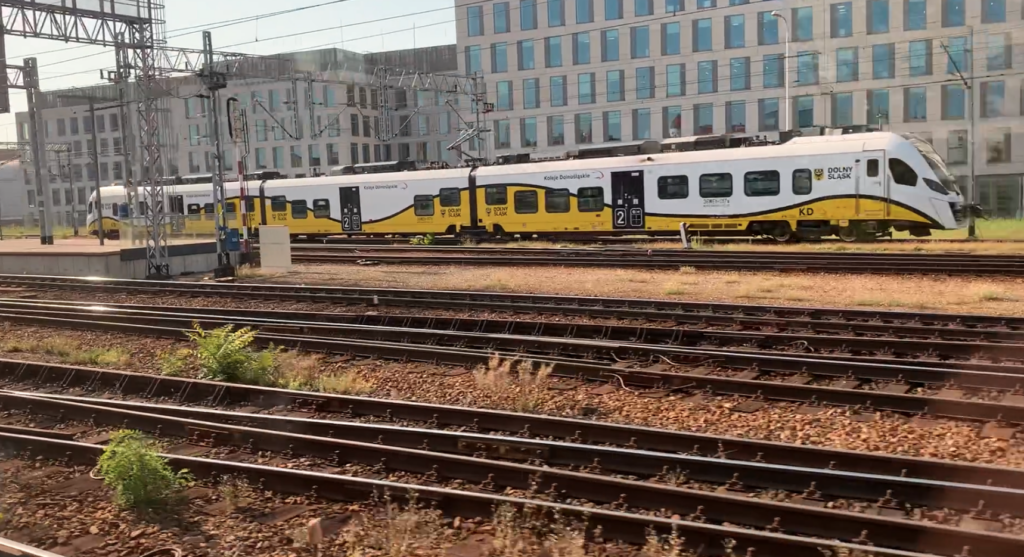
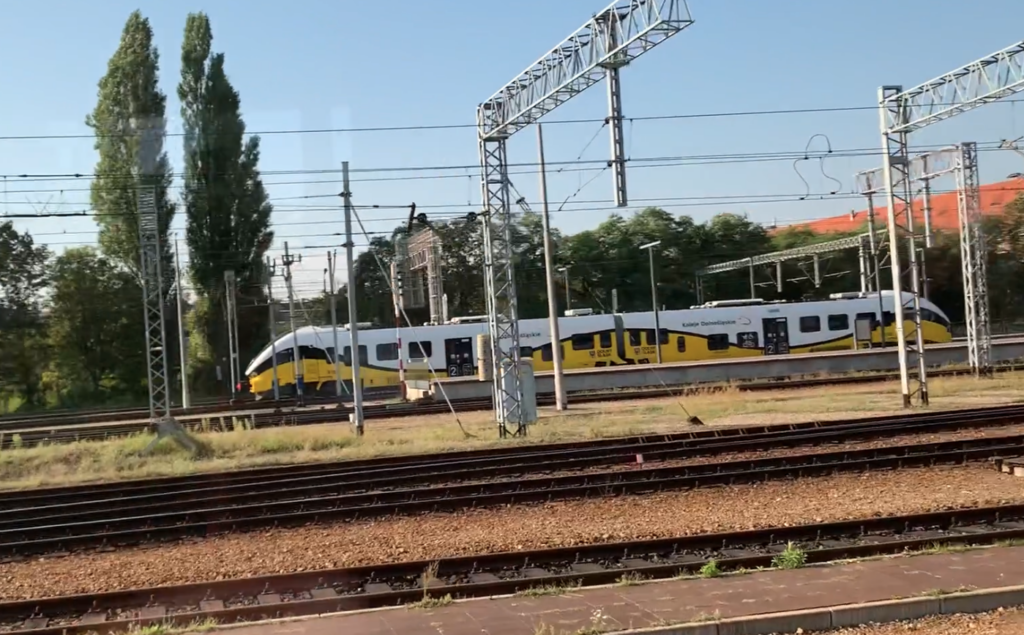
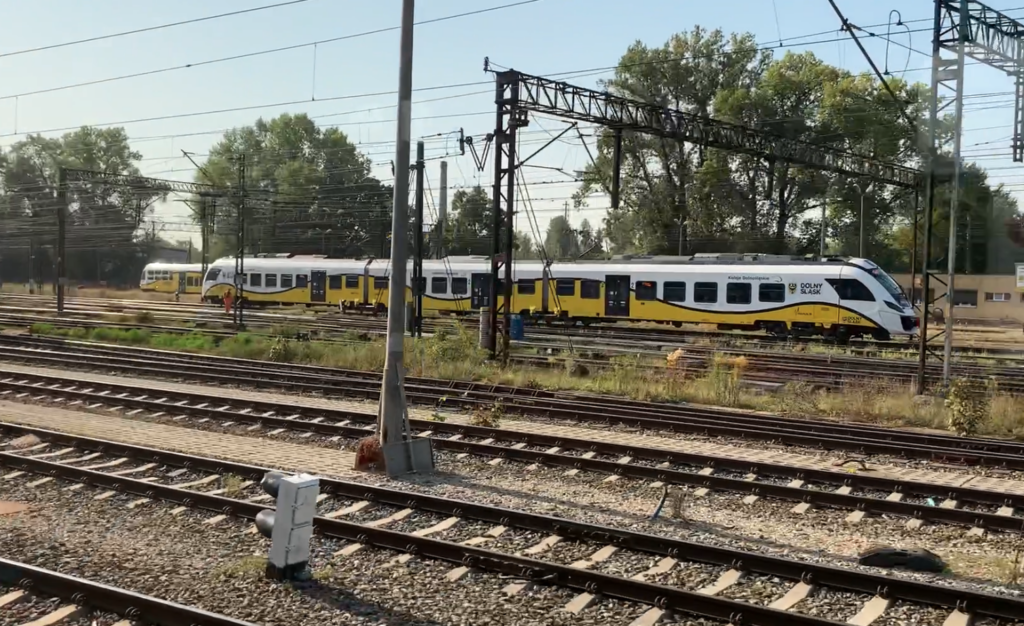
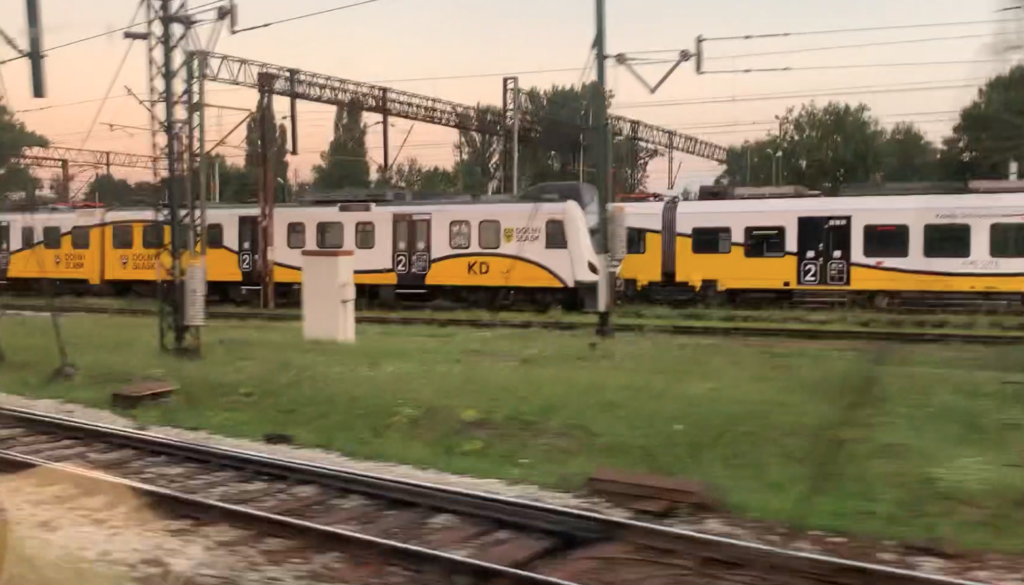
Koleje Dolnośląskie (KD) is a regional rail carrier operating in the Lower Silesian Voivodeship and neighboring regions. The company was founded on December 28, 2007 and is fully owned by the Lower Silesian Voivodeship government. The first regular KD trains ran on December 14, 2008.
KD operates numerous regional connections, connecting Wrocław with cities such as Legnica, Jelenia Góra, Wałbrzych, Kłodzko, Kudowa-Zdrój, Zgorzelec and with towns in the Czech Republic and Germany, including Görlitz, Dresden, Liberec and Adršpach. The company also offers seasonal connections to Berlin and the Baltic Sea, for example to Świnoujście. KD tickets are sold at KD ticket offices, ticket machines, online and from the conductors. PolRegio carrier tickets are accepted on KD trains. On the renovated railway sections, KD is launching replacement bus transport. KD has modern rolling stock, including NEWAG electric multiple units of the Impuls type (31WE, 36WEa, 45WE) and PESA Elf 2 (48WEc), as well as combustion vehicles SA134, SA135 and SA139. Over the past five years, the company has purchased 31 new trains; PESA 25 Elf 2 and 6 hybrid NEWAG Impuls 2.
As of May 10, 2025, Koleje Dolnośląskie has a modern and diverse fleet, including electric, hybrid and diesel vehicles. Below is a detailed list: EZT PESA Elf 2, 5-carriage, 35 trains, maximum speed 160 km/h, 250 seats in each train, maximum number of passengers 540 people. EZT NEWAG Impuls, types; 31WE, 36WEa, 45WE. Number of about 20 trains. Maximum speed 160 km/h. HZT Hybrid multiple units (electric-diesel) NEWAG Impuls 36WEh, 3-carriage, 6 trains. Maximum speed 160 km/h with electric traction and 120 km/h with diesel traction. Diesel multiple units. Number of 27 trains of various types.
KD has five freight cars adapted to transport bicycles. These cars are included in the trains during the holiday season and run to tourist destinations, mainly in the Sudetes.
In 2025, KD planned to acquire 10 new multi-car trains, with an option for an additional 20 trains. Among the options considered was the purchase of double-decker trains, which were planned to be operated on the most popular routes, for example Wrocław Główny – Legnica. There was also the purchase of 2 used trains, with an option for another 5 trains.
The railway network of Koleje Dolnośląskie (KD) includes an extensive network of regional and cross-border connections, connecting the main cities of Lower Silesia with smaller towns and with neighboring countries; Germany and the Czech Republic. KD operates on over 30 lines marked with the symbols D1-D99. This system covers about 350 km of lines, mainly electrified, and has been developed since 2009. Koleje Dolnośląskie (KD) is currently (2025) launching up to 520 connections per day in Lower Silesia and neighbouring regions. KD carries 60,000 passengers per day. Here are some of the key routes:
D1: Wrocław Główny – Legnica – Bolesławiec – Węgliniec – Lubań Śląski. D2: Wrocław Główny – Brzeg Dolny – Wołów – Ścinawa – Głogów. D3: Wrocław Główny – Kamieniec Ząbkowicki – Kłodzko Główne – Kudowa–Zdrój. D4: Wrocław – Sobótka – Świdnica – Bielawa Zachodnia. D5: Legnica – Świdnica – Dzierżoniów – Kłodzko – Kudowa-Zdrój. D6: Wrocław – Wałbrzych – Jelenia Góra – Szklarska Poręba Górna. D7: Wrocław Główny – Siechnice – Jelcz-Laskowice. D8: Wrocław Główny – Trzebnica. D9: Wroclaw – Strzelin – Kłodzko – Międzylesie – Lichkov (Czech Republic). D10: Wroclaw – Legnica – Węgliniec – Zgorzelec – Görlitz – Dresden (FRG). D11: Wroclaw Główny – Legnica – Lubin – Głogów. D12: Wroclaw Główny – Legnica – Lubin – Głogów – Nowa Sól. D13: Legnica — Chojnów — Rokitki — Chocianów. D14: Wroclaw Główny – Legnica – Żagań – Żary – Forst (Lausitz). D18: Görlitz – Zgorzelec – Węgliniec – Żagań – Żary – Zielona Góra Główna. D21: Szklarska Poręba Górna – Harrachov – Tanvald – Liberec (Czech Republic). D70: Wroclaw – Jelcz-Laskowice.
Examples of the number of connections on selected routes; Wrocław – Legnica: up to 36 pairs of trains per day. Wrocław – Jelcz Laskowice: 15 pairs of trains per day. In 2021, the KD company achieved revenue of PLN 1,932,303.80. In 2018, the carrier had a 3.78% market share, measured in terms of the number of passengers.
History of the creation of KD.
In the period 1989-2006, passenger traffic was eliminated on almost half of the railway lines in the Lower Silesian Voivodeship. Many railway routes were dismantled and railway stations were closed. The main reason was the inept management of entrusted assets. In Poland, the communists, who transformed into entrepreneurs, and in reality into freemasons, post-communists and Volksdeutsche, were not removed from power. There was no lustration and decommunization in Poland, and the effects of this are still with us today. We have people who were pulled out of formaldehyde who ran for the office of the President of Poland. Badly invested financial resources contributed to the collapse of the railways and the broadly understood economy. The railway infrastructure was not renovated. Energy-efficient railway vehicles were not put into operation. Making it difficult for private entities to enter the rail market. Forcing passengers to change to private bus transport, for example, through an unfavourable train schedule. Providing an offer inadequate to the needs of society. For example, only 6 pairs of trains on a given line, without the possibility of returning home after an afternoon shift at work or school. Discounts on the purchase of train tickets were eliminated. The authorities were hiding behind economic calculations, which forced the elimination of connections. They were not interested in poor people (without their own cars), pupils, students and the elderly. The elimination of technical and vocational education was also significant. Let us recall that in 1980, the PKP company transported 1,093 million people, and in 2001, only 309 million. The Polish authorities decided to transfer local transport to the hands of provincial governments, counting on the complete liquidation of the railways. The problem is that the residents forced the local governments to restore the rail connections.
Historically, Lower Silesia had a railway network of 2,300 km. The railway reached all cities and larger villages. In 2000, only 1,200 km of railway traffic was maintained. Under the decisions of the government, single-track and non-electrified railway lines were liquidated, as well as those where railway bridges required urgent and expensive repairs. Many counties were excluded from communication. In the next period of 2002-2006, there were further cuts in the number of train pairs on a given route. By the act of September 8, 2000, the PKP company was divided into 130 companies. Interestingly, the SKM railway in the Tri-City and the WKD in Warsaw operated on different principles. They were not affected by the cuts. Long-distance and express trains were also left separately. For local transport, the Przewozy Regionalne company was established. Further changes resulted in the government transferring responsibility for the state of regional rail transport within the provinces to local governments. This caused further isolation between the provinces. It took many months to work out a system for the provinces to acquire rolling stock. Only after three years were the first financing transferred to the provinces for transport within their own territory. Only then could the local governments begin to form organizational structures for future carriers. The first were the authorities of the Mazovian province, on July 24, 2004, to establish Koleje Mazowieckie with the participation of PKP Przewozy Regionalne. Of course, many other provinces tried to start with the subject, but it took them years.
In the Lower Silesian province, the plan was laid out for three years. Several variants were considered. 12 months were set for analyses and the creation of an agenda. Competition with Przewozy Regionalne (PolRegio) was taken into account. KGHM was chosen as the strategic investor, and diesel railbuses as the rolling stock. Ultimately, the sole owner of Koleje Dolnośląskie SA remained the Marshal’s Office of the Lower Silesian Voivodeship.
The company Koleje Dolnośląskie (KD) was established at the end of 2007, as a result of the resolution of the self-government assembly of the Lower Silesian Voivodeship, of 28 December 2007. Official operations were commenced on 6 February 2008. Staff training commenced in June 2008. The experimental track of the Railway Institute near Żmigród was used to train drivers. The company struggled to obtain the necessary certificates in Warsaw, in an inefficient state apparatus. KD had to start cooperation with PKP Cargo in Legnica, in order to maintain the rolling stock. The headquarters of KD was located in Legnica. On 6 December 2008, KD presented the first SA106-011 DMU vehicle. In December 2008, KD trains were launched on LK No. 137 (sub-Sudeten trunk line) and on LK No. 286 Legnica – Kłodzko – Międzylesie. From the very beginning, conductors sold tickets using portable terminals, which was a novelty in Poland. It was only later that ticket offices were opened at train stations. The KD company was the first company in Poland not financially linked to PKP.
After the KD company was established, passenger traffic was only restored on part of the line. On January 5, 2009, Koleje Dolnośląskie reactivated the Wałbrzych Główny – Nowa Ruda route. On July 29, 2009, KD obtained the National Safety Certificate and the European Safety Certificate. On September 28, 2009, Koleje Dolnośląskie leased the former wagon shed at Świdnica Przedmieście station. Not only were vehicles stationed there, but repairs and inspections were also started. On September 20, 2009, KD renovated the Wrocław Psie Pole – Trzebnica lines. Although the company was operating in the red (7 million zlotys in losses), the prospects were optimistic. In 2010, the loss amounted to only 43,000 zlotys. It also turned out that the Marshal’s Office was financially penalizing KD for delays in train operations. KD also failed to pay for the renovation of two 102A (Ryflak) type cars, which it never included in the trains. The invoice and the imposed penalties were paid at the beginning of 2011.
In 2011, the KD company purchased five electric multiple units manufactured by NEWAG Nowy Sącz, which have been operating on electrified routes since 2013. In 2012, the Wrocław – Legnica route was extended to Żagań – Żary. In 2012, the company carried 1.8 million passengers. In 2013, the following connections were reactivated: Kłodzko – Polanica Zdrój, Wrocław – Świdnica Miasto and Kłodzko Główne – Kudowa Zdrój. In 2014, an agreement was concluded with NEWAG for 6 3-car trains and 5 4-car trains, as well as with PESA for 4 Link diesel trains. In 2015, online ticket sales began. The company began negotiations with the Czech Republic and Germany to launch cross-border connections. In 2015, KD started services on the Wrocław – Rawicz route, as well as Wrocław – Dresden. In 2016, ticket machines were installed in selected trains. In 2016, the historic Wrocław – Berlin connection was launched, together with Deutsche Bahn (RFN). This connection operated for two seasons. In 2016, construction of a new train service hall in Legnica and a training center began. A 45WE Impuls electric multiple unit simulator was placed in the training center. In 2017, KD signed a contract with NEWAG for 11 5-car EZT trains of the 45WE Impuls type, which were delivered by the end of 2017. The new rolling stock allowed for an increase in the number of connections. In 2018, KD started selling tickets via the KOLEO portal. In 2019, the Wrocław – Lubin connection was restored. In 2020, KD signed a contract with PESA for the delivery of 5 EZT trains of the Elf 2 type in a 5-carriage version. In 2022, connections were launched on the new D13 line on the Legnica – Chojnów – Rokitki – Chocianów route. In 2023, a connection was launched on the D41 line on the Świdnica Miasto – Zagórze Śląskie – Jedlina-Zdrój – Głuszyca route. In 2023, a long-distance connection was launched on the Wrocław Główny – Legnica – Lubin – Głogów – Zielona Góra Główna – Szczecin Dąbie – Międzyzdroje – Świnoujście route. This was a holiday connection. In 2023, the cross-border connection Wrocław – Berlin was restored. In 2023, KD carried 19 million passengers, which was the best result in the fifteen-year history of Koleje Dolnośląskie.
The KD company does not own railway stations, but uses them only on the basis of agreements with the owners; mainly the PKP PLK company. Tickets are sold on the KD train using the conductor’s terminal or in ticket machines on trains and at stations, as well as online. The KD has its own ticket offices at the following stations: Bolesławiec, Jelenie Góra, Legnica, Strzelin, Szklarska Poręba Górna, Wałbrzych Miasto, Wrocław Główny, Zgorzelec Miasto. Tickets can also be purchased at all ticket offices of the PolRegio company.
Diesel rolling stock: Type 212M series SA109, 2 units, Kolzam. Type 214Mb series SA135, 10 units, PESA. Type 218M series SA132/134, 8 units, PESA/ZNTK Mińsk Mazowiecki. Type 223M series SA139, 4 units, PESA.
Electric rolling stock: Type Impuls 31WE, 10 units, NEWAG. Type Impuls 36WEa, 6 units, Newag. Type Impuls 45WE, 11 units, NEWAG. Type Elf 2 series 48WEc, 25 units, PESA. EN57AL, 3 units, PaFaWag. EN57, 2 units, PaFaWag.
Hybrid rolling stock: NEWAG Impuls 36WEh, 6 units.
Wagons for transporting bicycles manufactured by ZASTAL type 208K, 5 units.
Written by Karol Placha Hetman
